SBOS722B June 2015 – August 2016 TMP461
PRODUCTION DATA.
- 1 Features
- 2 Applications
- 3 Description
- 4 Simplified Block Diagram
- 5 Revision History
- 6 Pin Configuration and Functions
- 7 Specifications
-
8 Detailed Description
- 8.1 Overview
- 8.2 Functional Block Diagram
- 8.3 Feature Description
- 8.4 Device Functional Modes
- 8.5 Programming
- 8.6
Register Map
- 8.6.1
Register Information
- 8.6.1.1 Pointer Register
- 8.6.1.2 Local and Remote Temperature Registers
- 8.6.1.3 Status Register
- 8.6.1.4 Configuration Register
- 8.6.1.5 Conversion Rate Register
- 8.6.1.6 One-Shot Start Register
- 8.6.1.7 Channel Enable Register
- 8.6.1.8 Consecutive ALERT Register
- 8.6.1.9 η-Factor Correction Register
- 8.6.1.10 Remote Temperature Offset Register
- 8.6.1.11 Manufacturer Identification Register
- 8.6.1
Register Information
- 9 Application and Implementation
- 10Power Supply Recommendations
- 11Layout
- 12Device and Documentation Support
- 13Mechanical, Packaging, and Orderable Information
パッケージ・オプション
メカニカル・データ(パッケージ|ピン)
- RUN|10
サーマルパッド・メカニカル・データ
- RUN|10
発注情報
7 Specifications
7.1 Absolute Maximum Ratings
over operating free-air temperature range (unless otherwise noted)(1)| MIN | MAX | UNIT | ||
|---|---|---|---|---|
| Power supply | V+ | –0.3 | 6 | V |
| Input voltage | THERM, ALERT/THERM2, SDA and SCL only | –0.3 | 6 | V |
| D+, A0, A1 | –0.3 | (V+) + 0.3 | ||
| D– only | –0.3 | 0.3 | ||
| Input current | 10 | mA | ||
| Operating temperature | –55 | 150 | °C | |
| Junction temperature (TJ max) | 150 | °C | ||
| Storage temperature, Tstg | –60 | 150 | °C | |
(1) Stresses above these ratings may cause permanent damage. Exposure to absolute maximum conditions for extended periods may degrade device reliability. These are stress ratings only, and functional operation of the device at these or any other conditions beyond those specified is not implied.
7.2 ESD Ratings
| VALUE | UNIT | |||
|---|---|---|---|---|
| V(ESD) | Electrostatic discharge | Human body model (HBM), per ANSI/ESDA/JEDEC JS-001(1) | ±2000 | V |
| Charged device model (CDM), JEDEC specification JESD22-C101(2) | ±1000 | |||
(1) JEDEC document JEP155 states that 500-V HBM allows safe manufacturing with a standard ESD control process.
(2) JEDEC document JEP157 states that 250-V CDM allows safe manufacturing with a standard ESD control process.
7.3 Recommended Operating Conditions
over operating free-air temperature range (unless otherwise noted)| MIN | NOM | MAX | UNIT | ||
|---|---|---|---|---|---|
| V+ | Supply voltage | 1.7 | 3.3 | 3.6 | V |
| TA | Operating free-air temperature | –40 | 125 | °C | |
7.4 Thermal Information
| THERMAL METRIC(1) | TMP461 | UNIT | |
|---|---|---|---|
| RUN (WQFN) | |||
| 10 PINS | |||
| RθJA | Junction-to-ambient thermal resistance | 123.1 | °C/W |
| RθJC(top) | Junction-to-case (top) thermal resistance | 60.1 | °C/W |
| RθJB | Junction-to-board thermal resistance | 78.1 | °C/W |
| ψJT | Junction-to-top characterization parameter | 4.6 | °C/W |
| ψJB | Junction-to-board characterization parameter | 78.1 | °C/W |
(1) For more information about traditional and new thermal metrics, see the Semiconductor and IC Package Thermal Metrics application report, SPRA953.
7.5 Electrical Characteristics
At TA = –40°C to 125°C and V+ = 1.7 V to 3.6 V, unless otherwise noted.7.6 Two-Wire Timing Requirements
At –40°C to 125°C and V+ = 1.7 V to 3.6 V, unless otherwise noted.| FAST MODE | HIGH-SPEED MODE | UNIT | |||||
|---|---|---|---|---|---|---|---|
| MIN | MAX | MIN | MAX | ||||
| f(SCL) | SCL operating frequency | 0.001 | 0.4 | 0.001 | 2.17 | MHz | |
| t(BUF) | Bus free time between stop and start condition | 1300 | 160 | ns | |||
| t(HDSTA) | Hold time after repeated start condition. After this period, the first clock is generated. |
600 | 160 | ns | |||
| t(SUSTA) | Repeated start condition setup time | 600 | 160 | ns | |||
| t(SUSTO) | Stop condition setup time | 600 | 160 | ns | |||
| t(HDDAT) | Data hold time | 0 | 900 | 0 | 150 | ns | |
| t(SUDAT) | Data setup time | 100 | 40 | ns | |||
| t(LOW) | SCL clock low period | 1300 | 320 | ns | |||
| t(HIGH) | SCL clock high period | 600 | 60 | ns | |||
| tF – SDA | Data fall time | 300 | 130 | ns | |||
| tF, tR – SCL | Clock fall and rise time | 300 | 40 | ns | |||
| tR | Rise time for SCL ≤ 100 kHz | 1000 | ns | ||||
 Figure 1. Two-Wire Timing Diagram
Figure 1. Two-Wire Timing Diagram
7.7 Typical Characteristics
At TA = 25°C and V+ = 3.6 V, unless otherwise noted.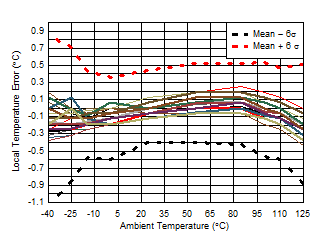
| Typical behavior of 25 devices over temperature |
Ambient Temperature
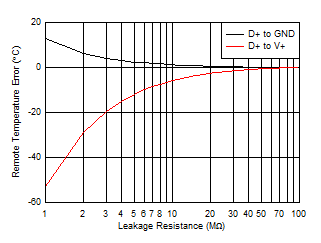
Leakage Resistance
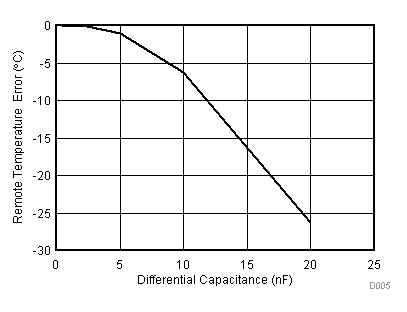
| No physical series resistance on D+, D– pins during measurement |
Differential Capacitance
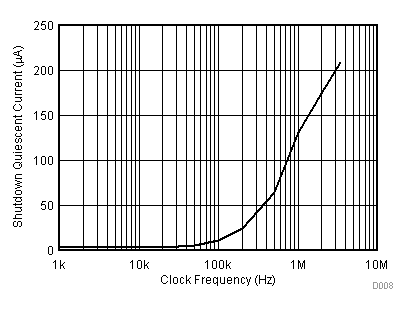
| 16 samples per second (default mode) | ||
vs SCL Clock Frequency
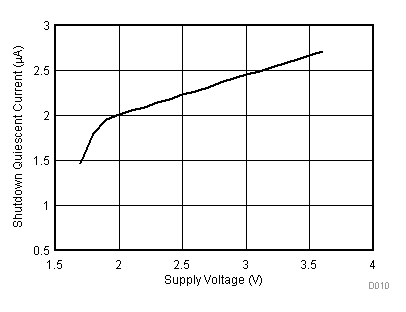
vs Supply Voltage
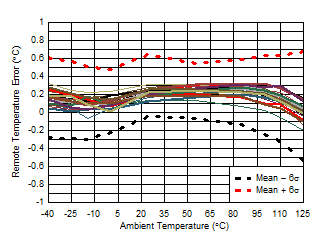
| Typical behavior of 25 devices over temperature |
Ambient Temperature
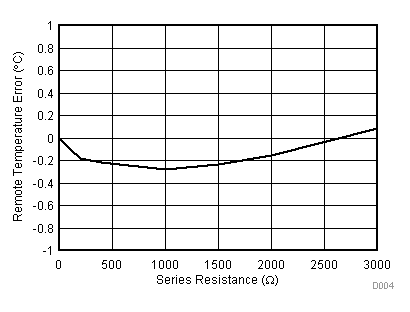
| No physical capacitance during measurement |
Series Resistance
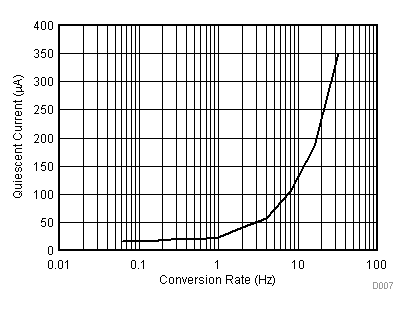
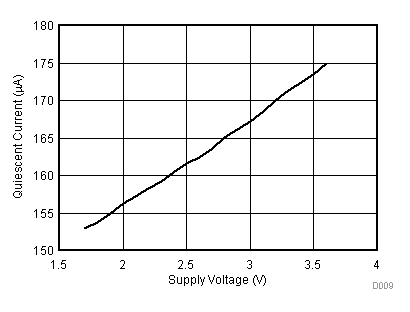
(At Default Conversion Rate of 16 Conversions per Second)